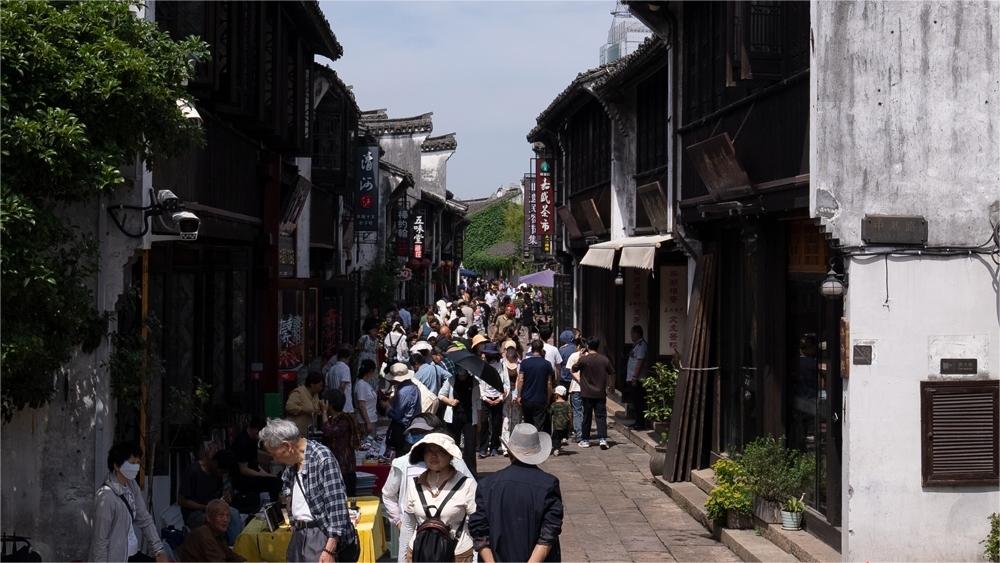Mountain Rescue team reaches peaches for peak efficiency
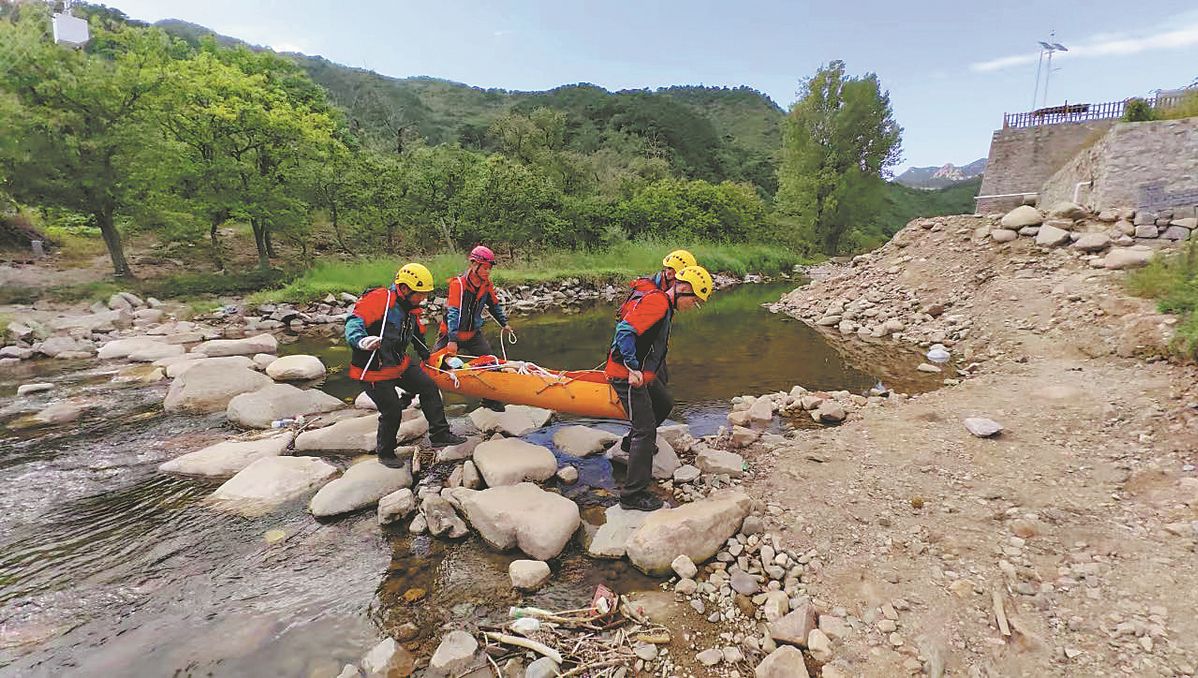
Firefighters from the Beijing Mountain Rescue Team in Huairou carry an injured tourist on a stretcher in September. The tourist had injured his waist and legs when picking chestnuts on the mountain. China Daily
At 9:01 am on May 19, Wang Qiong received a phone call asking for help from a watchtower at a remote section of the Great Wall. The caller said that five people had been struck by lightning and one of them was unconscious.
Wang reacted quickly, asking: "Where are you exactly? Were you climbing the mountain from the east side of a village, where a parking lot is located? Did you turn left after reaching the peak?"
After multiple questions, Wang was sure of where the incident had happened and took seven team members with him to rescue the hikers who were trapped in a dangerously steep section of the Great Wall.
After an hour of hiking and climbing, the team arrived on the scene with rescue equipment. The injured man was weak but conscious, with a slow heartbeat. The other four people were in reasonable condition, a video posted by the Beijing Fire Rescue Corps showed.
The firefighters used a torso-protecting air bag to immobilize the injured man and spent two more hours transferring him to the foot of the mountain. He was placed in an ambulance at 12:34 pm.
"It was my mission to rescue them," said Wang, deputy director of a squad of Beijing Mountain Rescue Team. "I felt very relieved that the task could be completed because of me."
It is the 11th year that 29-year-old Wang has participated in professional mountain rescue operations in the Huairou district on Beijing's northern outskirts. The district is home to 24 mountains with elevation above 2,000 meters, and 90 percent of its terrain is mountainous.
The hilly landscape, along with steep hiking routes, attracts a large number of visitors throughout the year. In 2018, the local firefighting department set up the Beijing Mountain Rescue Team, consisting of six squads, to deal with accidents and searches.
"Huairou has about 60 to 70 outdoor accidents every year," said Wang. "The incidents are not limited to the summer or winter months, but occur across all four seasons."
Spring has a high number of outdoor incidents. The day before Wang received the call for help, his colleague, Li Yong, director of another of the Huairou squads, and his team spent more than three hours rescuing an injured hiker near Xiangshui Lake scenic spot.
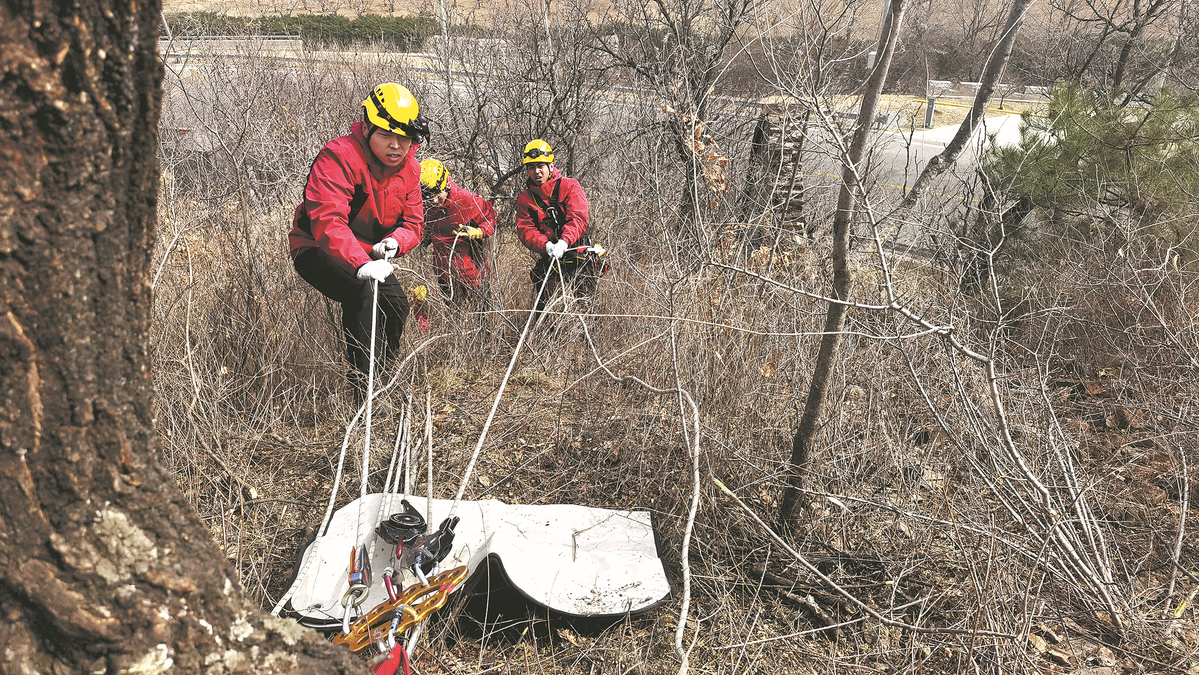
Firefighters from the Beijing Mountain Rescue Team participate in rescue training in Beijing. CHINA DAILY
Difficult terrain
Li, 36, who has almost two decades of experience rescuing tourists in the mountains, said the steep terrain does not have typical hiking routes. It takes longer to rescue injured people even though they might only be a short distance away, he said.
"It was only about 300 meters (from the foot of the mountain to where the injured person was)," he said of the May 18 rescue. "We worked in relays to carry the stretcher down the mountain with a pathfinder checking the route, which took about two hours," Li said.
It's also difficult to assess the extent of a person's injuries on the spot. When his team arrived at the scene, the injured person's ankle had stopped bleeding and the firefighters thought his injury might not be too serious.
"We also hadn't brought our first-aid kit to the scene, and we couldn't determine whether the ankle was OK or not due to the (injured person's) waterproof rubber climbing boots," Li said. "But when I attempted to have the injured person moved to the stretcher and asked him if his right toe could touch the ground, I noticed something was wrong.
"When his right foot moved slightly, the entire foot drooped, indicating that his right ankle was badly broken and that the injured person didn't know that yet.
"I guess that the hiker tried to ascend the steep hill by stepping onto a crack in a rock, slipped, and lost his grip, resulting in a serious ankle injury."
The two incidents on one weekend are an indication of the growing need for such rescue services as outdoor sports undergo rapid growth across the country. China's outdoor enthusiast population has reached 130 million, a report released by the General Administration of Sport last October showed. Orders for goods related to outdoor sports rose by 79 percent year-on-year during the first half of last year, an increase of 221 percent compared with the same period in 2019.
"The most common reason for a rescue occurs when people take an outdoor adventure beyond their capabilities, in regard to either their experience or physical strength," said Wang.
"This includes lacking the skills to know what to bring or how to prepare, deviating from established scheduled routes, and getting injured," he said.
Most of the rescue calls are made at sunset, around 6 or 7 pm, or after 10 pm, Wang said.
"Sometimes experienced hikers think they might be able to descend a mountain on their own and they begin searching for alternative routes by themselves. However, when it gets close to 10 o'clock at night, the hikers who have lost their way turn to us for help," he said.
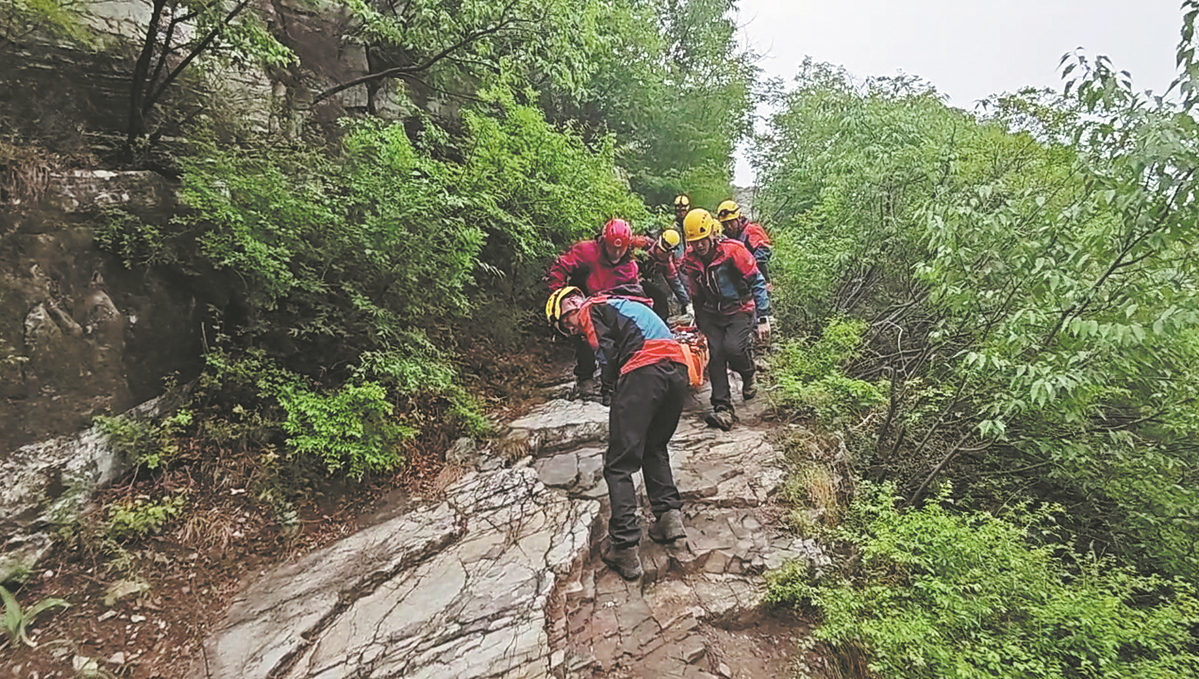
Firefighters rescue an injured hiker from a steep mountain in Huairou, Beijing, in May. China Daily
Exact location
Locating people in need of rescue takes time and effort. Wang said this is the most important part of an outdoor rescue.
Before a rescue team starts a mission, Wang said the first part of the procedure is to talk to the person seeking help and establish what their injuries are, and whether they can walk.
"When someone needs to be rescued, knowing their exact condition is a necessary requirement because the number of rescuers dispatched and the equipment carried will depend on that information," Wang said.
The location function on WeChat or snapshots of routes taken from hiking Apps, play vital roles in rescue teams quickly locating a person. However, in most cases this is complicated by the mountainous terrain or the depletion of the cellphone battery. This results in rescues in such terrain often exceeding 10 hours, he said.
"We have established a mechanism to cope with prolonged rescue missions," Wang said.
"Another team of six firefighters, serving as a backup rescue force, will be deployed if the initial team has been searching for more than 10 hours. The team on the mountain will schedule rotations, and descend to rest and eat. The next team takes over the search operations, using cellphones and beepers as communication tools."
The Beijing Mountain Rescue Team carries out searches and rescues at the request of the police, and almost the entire operation is government-funded.
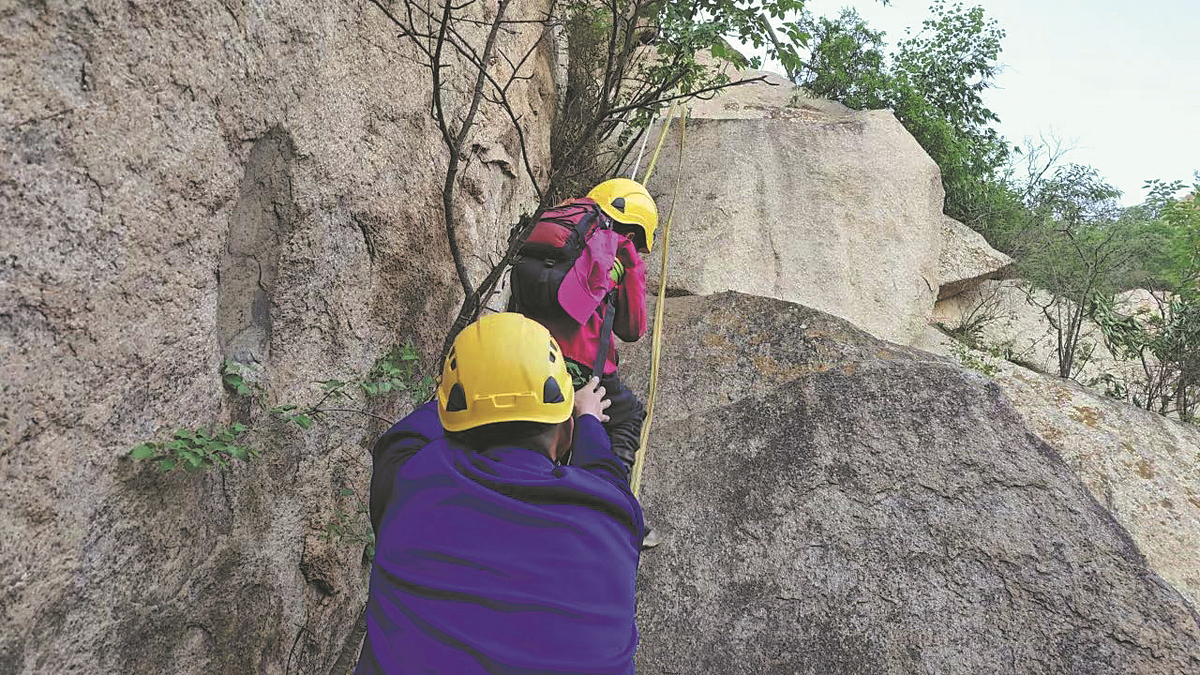
A firefighter rescues a boy trapped on a mountain in Huairou district, Beijing, in May. China Daily
Paying the price
Today, all rescue operations are free, but more than a decade ago firefighting teams sometimes needed the help of a paid local guide to locate a person lost or injured in remote terrain.
This sometimes led to disputes and negotiations over payment of the guide, Li said.
A native of Chuxiong Yi autonomous prefecture, Yunnan province, Li has worked as a firefighter in Beijing's Huairou district since 2008.
"But in my earliest days as a mountain search and rescuer, I was not familiar with the mountain environment and relied on local guides to find routes for search and rescue operations," he said.
Paying for a local guide could be a complicated issue, and payment disputes between the rescue team and the person needing rescue sometimes arose.
Li said when a tourist or hiker was trapped and told that a paid guide was needed to locate them, they usually agreed to the arrangement.
However, Li said since 2010 he has been able to find the mountain routes independently to conduct rescues and searches. "In the area within the jurisdiction of my squad, I have climbed almost every mountain," he said.
For firefighters, saving people's lives is their top priority. But the opposite side of the coin is a feeling of powerlessness when a rescue is unsuccessful. "If you can't save a life, you'll definitely feel disappointed," Li said.
In mountainous areas with scattered stones and rocks, the chances of accidents occurring are almost inevitable.
"Stones on a mountain are exposed to the sun every day, making them loose in summer when the sunlight is most intense," said Wang. "The constant exposure also contributes to weathering. When climbing a mountain, a hiker may suddenly step on a stone, fall down a slope, stand up, and take a few steps with fractured bones.
"If there are no trees or other barriers blocking the way, the fall may continue for dozens of meters," he said.
Other dangerous situations include when fallen leaves cover the ground in autumn and a hiker slips or steps on weathered stones and injures an ankle, he said.
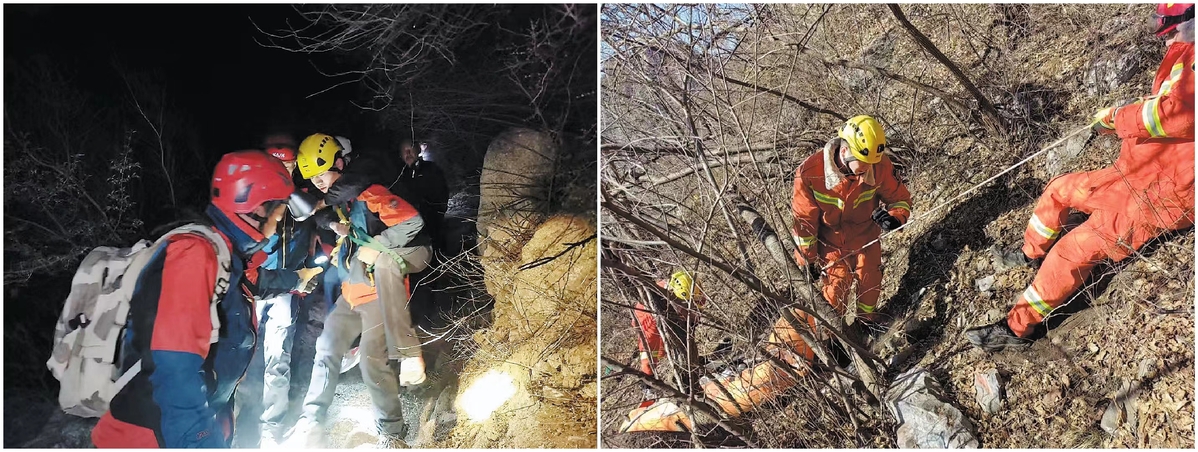
Left: Firefighters from Beijing's Huairou district rescue a hiker from an animal trap in March. Right: Firefighters rescue an injured hiker in December who was unable to walk. China Daily
Reducing risks
If a person is rescued or injured in an unsafe outdoor environment, they are usually lectured by police on the risks as a way to deter any future harm or danger.
"Most of the time, it's simply verbal persuasion, saying that climbing an off-limits mountain is illegal. But the hikers face no further penalties," Wang said.
Educating outdoor enthusiasts and promoting legislation related to mountain entry are appropriate ways to reduce risks, said Zhang Hongquan, deputy director of the Beijing Mountaineering Association.
Zhang, an outdoor enthusiast himself, learned outdoor rescue skills, such as rope-tying and emergency medical care, on his own. In the early 2000s, he established a civilian mountain rescue team in Beijing, which has more than 40 volunteers.
Learning survival knowledge and wilderness skills are essential for outdoor enthusiasts to remain safe, he said.
"If someone knows that drinking lightly salted water is beneficial, but is unaware that it can help save strength over a period of strenuous longtime exercise, they might be missing a helpful strategy," Zhang said.
Lectures on safety tips by experienced outdoor enthusiasts, as well as social media influencers, could be effective in raising awareness about the issue, he said.
"But to better prevent a group of people from serious injuries when they enter a mountain area, the development of an early warning system could be more effective," he said.
"Prior to entering a mountain, people could register through a program that tracks their location if they do not exit within a specified time period.
"The system will automatically sound an alarm and contact the person directly," he said. "It is a rescue method that saves time in locating people in need of help and reduces cost."
Zhang said implementing such a system will need a legal basis as well as coordination and cooperation between multiple government departments.
Photos
Related Stories
- Rescue work underway as 6.2-magnitude earthquake ravages Gansu
- Chinese vice premier urges intensified emergency rescue, flood response work
- Helicopter engages in search and rescue training
- Firefighters rescue boy hanging from rooftop
- Quick-acting soldier saves fallen elderly man
- High ice waterfall rescue drills in Urumqi, Xinjiang
Copyright © 2024 People's Daily Online. All Rights Reserved.






